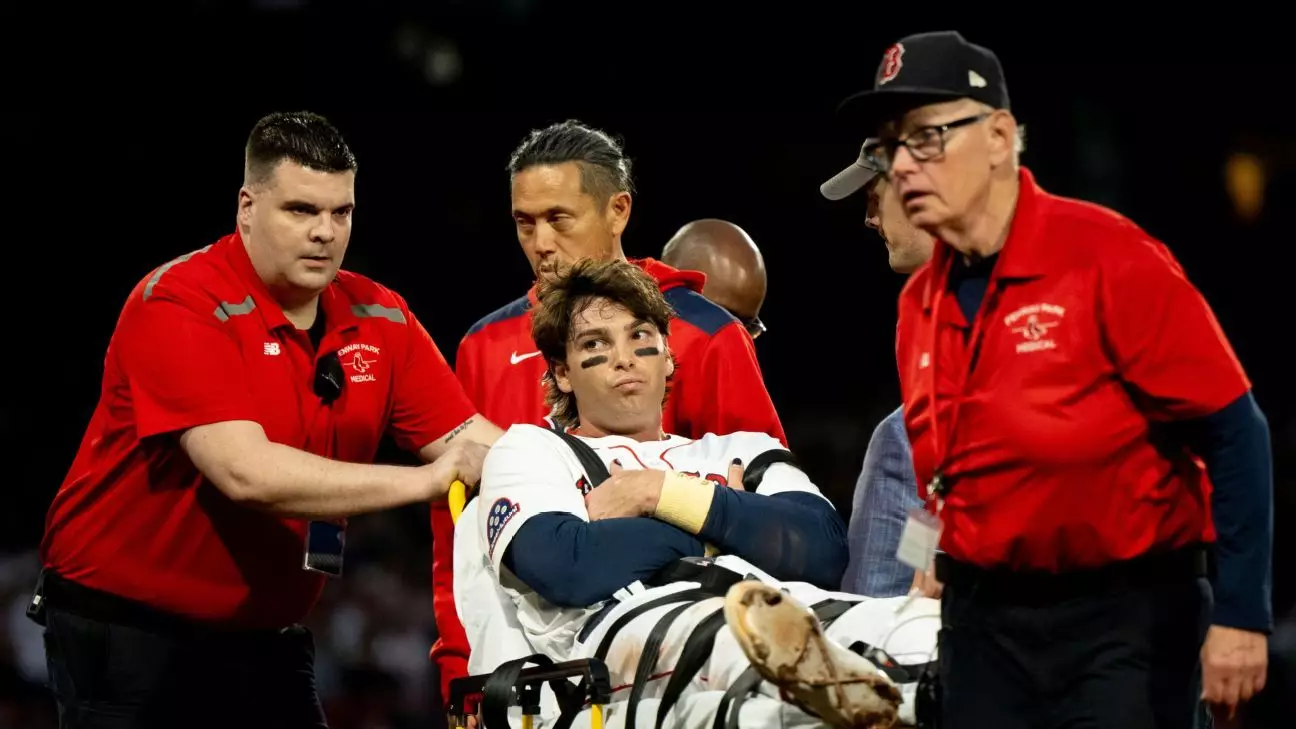In a somber turn of events, the Boston Red Sox have reported that first baseman Triston Casas will be sidelined for the remainder of the season due to a ruptured patellar tendon in his left knee. The injury occurred during a crucial moment in a game against the Minnesota Twins. This painful incident not only halts the promising trajectory of a young athlete but also raises broader questions about injury management and team depth in professional sports. At just 25 years old, Casas’s aspirations for a breakout season have been abruptly overshadowed by the despair of an injury that demands not just surgical intervention but an extensive rehabilitation process.
The Incident: A Moment of Misfortune
The rupture happened as Casas sprinted towards first base after hitting a slow roller along the line. A seemingly innocuous play quickly transformed into a nightmare as he collapsed awkwardly, holding his knee in agony. The swift response from medical personnel, who carted him off the field, conveys the immediate gravity of his condition. The distress felt by teammates, staff, and fans alike was palpable, marking a tragic chapter in what was anticipated to be a pivotal season for the first baseman. His consequent surgery at Massachusetts General Hospital, performed by Dr. Eric Berkson, is a testament to the seriousness of his injury, prompting a tidal wave of concern from within the organization.
Impact on the Team
Chief baseball officer Craig Breslow’s remarks resonate deeply in the wake of this injury. While he acknowledged Casas’s struggles with a batting average of just .182, he also emphasized the intangible qualities that the first baseman brought to the squad, including his charisma and defensive prowess. These elements are just as critical as offensive statistics in a team sport where morale can be just as vital as individual performance. In Casa’s absence, the Red Sox lose not only a player but also a key contributor to their clubhouse culture—a challenging void in any professional sports team.
Perseverance in the Face of Challenge
Manager Alex Cora pointedly noted the progress Casas had made during the offseason, highlighting his dedication to overcoming previous setbacks, including a significant injury last season. This injury’s timing is a harsh reminder that even the most prepared athletes are vulnerable to circumstances beyond their control. Notably, Casas’s approach to this season focused on relaxation at the plate, a psychological framework that sought to relieve the pressures he and many athletes place upon themselves. The unfortunate irony is that while striving for this mindful state, he has been consigned to the sidelines.
Looking Ahead: The Path to Recovery
As the Red Sox adjust their roster—bringing in infielder/outfielder Abraham Toro and exploring other options—Casas is now tasked with a meticulous recovery plan designed to ensure he returns stronger than ever. The team is not only compelled to reconfigure its playing strategy but also faces a crucial decision-making period regarding long-term roster fill-ins or trade options. This situation presents a substantial opportunity for strategic adjustments within the organization. The search for a solution to replace his presence will likely extend beyond immediate tactical changes to long-term investments in player development and external acquisitions.
Maintaining Team Cohesion
Despite the turmoil surrounding Casas’s injury, Cora remained optimistic about the team’s ability to adapt. The conversation about not transferring Rafael Devers from third base to first demonstrates a commitment to maintaining stability amidst a turbulent landscape. By pivoting players within established roles rather than extensively reshuffling the lineup, the Red Sox aim to preserve their competitive edge. This balanced approach may serve to bolster the team’s defense and allow for smoother transitions as the roster continues to evolve in light of inevitable injuries and performance fluctuations.
Final Thoughts
Triston Casas’s injury is undoubtedly a setback for the Red Sox, encapsulating the unpredictability of sports. As he embarks on a daunting recovery journey, the atmosphere within the team is one of cautious optimism. This incident serves as a reminder of the fine line athletes tread between resilience and vulnerability, an aspect not lost on teams or their dedicated fanbases. The road ahead is fraught with challenges, but within that struggle lies the potential for growth and resurgence—both for Casas as an individual and for the Boston Red Sox as a team.


Leave a Reply